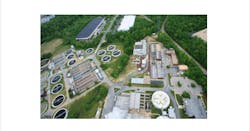The Little Patuxent Water Reclamation Plant (LPWRP) serves the heart of Howard County, Maryland. The sewage collection system recently underwent a $92 million upgrade to improve the quality of the plant’s effluent discharge and reduce harmful nutrients reaching Chesapeake Bay.
Project Background
With a geographic footprint of 64,229 square miles, Chesapeake Bay ranks as the nation’s largest estuary and receives flows from 150 rivers and streams. The multi-state region’s growth over the past 50 years has brought an inevitable surge in byproduct nutrients from wastewater treatment plants that steadily eroded the vitality of the Bay’s water environment.
“The chronic erosion of the Bay’s water quality has had negative impacts on plant and animal life—particularly the fishery and oyster industries.”
In the estuary and along its tributaries, nitrogen and phosphorus are the major problems attributed to several sources but are caused in large part by wastewater treatment plant discharges reaching the Bay.
Solution
Following exhaustive evaluations, consulting firm Atkins Global recommended an Enhanced Nutrient Removal (ENR) upgrade comprised of seven deep-bed mono-media Leopold elimi-NITE® 2.0 denitrification filters along with FilterWorx® control systems and related ancillary equipment.
Other equipment was also supplied by Xylem including a 400- lamp WEDECO TAK 55 UV disinfection system, Flygt brand propeller mixers and related headworks screening, dewatering and clarification equipment.
An additional 7,000 Sanitaire ceramic diffusers were added to the process reactor aeration grids and the existing centrifugal blowers were replaced with a new turbo-type unit. The capacity of the existing Biological Nutrient Removal (BNR) process was expanded with a new process reactor, secondary clarifier, launder covers on the secondary clarifiers, and a new solids processing centrifuge.
The ENR system now in operation can scrub the effluent down to 3 or 4 mg/L of Total Nitrogen compared to 8 mg/L achieved by the earlier BNR method.
Result
In tandem with the phosphorous removed upstream in the process reactors, total phosphorous can be reduced to 0.2 mg/L or less.
LPWRP’s daily reductions equate to an impressive 37,000 pounds of suspended solids, 4,730 pounds of nitrogen and 965 pounds of phosphorous. The individual plant will increase by more than 16 million pounds the statewide nitrogen reductions achieved by earlier upgrades across the state’s wastewater treatment infrastructure. Adding ENR to the state’s 66 largest plants should potentially reduce nutrient loading by another 7.5 million pounds of nitrogen and 260 thousand pounds of phosphorus per year.
Editor's Note: Scranton Gillette Communications and the SGC Water Group are not liable for the accuracy, efficacy and validity of the claims made in this piece. The views expressed in this content do not reflect the position of the editorial teams of Water & Wastes Digest, Water Quality Products and Storm Water Solutions.
